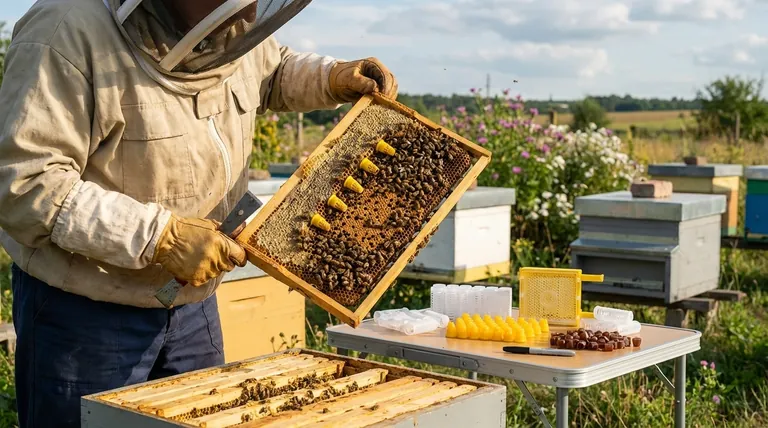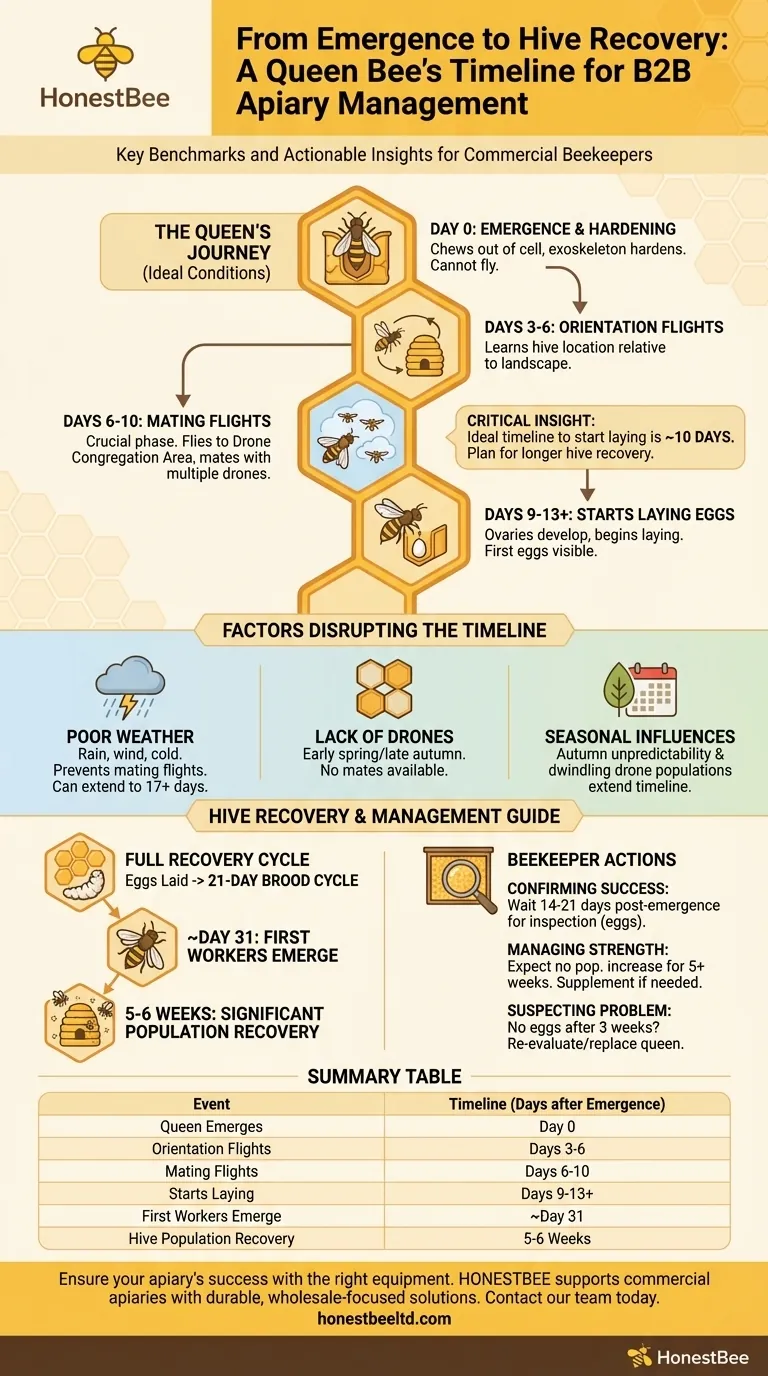Under ideal conditions, a new virgin queen will take her mating flights and begin laying her first eggs approximately 10 days after she emerges from her queen cell. This timeline is a crucial benchmark for beekeepers, but it represents only the beginning of the hive's recovery cycle. The entire process, from the queen laying her first egg to her new offspring emerging as adult workers, takes significantly longer.
The critical insight for any beekeeper is to distinguish between the queen's initial egg-laying and the hive's full recovery. While a queen can start laying in about 10 days, you must plan for a 5-to-6-week timeline before her first generation of worker bees begins to strengthen the colony's population.

The Queen's Journey: A Step-by-Step Timeline
Understanding the key milestones in a new queen's life is essential for managing a hive and knowing when to intervene. The "10-day" figure is an average composed of several distinct stages.
Day 0: Emergence and Hardening
A virgin queen chews her way out of her wax cell. For the first few days of her life, she is not yet ready to fly. Her primary focus is on allowing her exoskeleton to harden and mature.
Days 3-6: Orientation Flights
Before she can mate, the queen must learn the location of her colony. She will take a series of short orientation flights, circling the hive to memorize its position relative to the surrounding landscape.
Days 6-10: The Mating Flights
This is the most critical and perilous phase. The queen will fly to a "Drone Congregation Area," where she mates with multiple drones in mid-air. She stores the sperm from these encounters for the rest of her life.
Days 9-13+: The Start of Laying
After successfully mating, the queen returns to the hive. It takes a few more days for her ovaries to fully develop, after which she will begin the primary job of her life: laying eggs.
Factors That Can Disrupt the Timeline
The 10-day average is highly dependent on external factors. A patient beekeeper understands that delays are common and often outside of anyone's control.
Poor Weather Conditions
This is the most common cause of delay. Rain, high winds, and cold temperatures will keep a virgin queen confined to the hive, preventing her from taking her necessary mating flights. A week of bad weather can easily push the timeline to 17 days or longer.
Lack of Drones
A queen cannot mate if there are not enough mature, healthy drones in the local area. This is most common very early in the spring or late in the autumn.
Seasonal Influences
As noted, the timeline can extend considerably in the autumn. This is due to a combination of less predictable weather and a dwindling drone population as the season winds down.
From Laying to Recovery: The Full Picture
Seeing the first eggs is a sign of success, but it does not mean the hive is out of the woods. The colony's population has been dwindling since it became queenless, and it needs new workers to recover.
The 21-Day Brood Cycle
From the moment the queen lays an egg, it takes approximately 21 days for that egg to develop into an adult worker bee.
The 5-Week Recovery Window
When you combine the queen's timeline with the brood cycle, the reason for the longer recovery period becomes clear. If a queen starts laying on Day 10, her first worker offspring will not emerge until around Day 31.
Rebuilding the Workforce
It will take another one to two weeks after the first workers emerge for their numbers to be significant enough to truly bolster the hive's population and workforce. This is why the full recovery cycle is often cited as 5 to 6 weeks.
How to Manage Your Hive During This Period
Your actions as a beekeeper should be guided by this complete timeline, balancing the need to confirm success with the need to avoid disturbing the colony.
- If your primary focus is confirming the queen has mated: Give her at least 14 to 21 days from her emergence date before performing an inspection for eggs, especially if the weather has been poor.
- If your primary focus is managing hive strength: Do not expect to see a population increase for at least 5 weeks. Plan supplemental feeding if necessary to support the existing bees until the new generation emerges.
- If you suspect a problem: After 3 weeks with no sign of eggs, you must perform a careful inspection. If you find no queen and no eggs, it is time to consider that the queen was lost and the hive needs a new one.
Understanding this full timeline allows you to manage your hive with patience and precision, ensuring its long-term success.
Summary Table:
| Event | Timeline (Days After Emergence) |
|---|---|
| Queen Emerges from Cell | Day 0 |
| Orientation Flights | Days 3-6 |
| Mating Flights | Days 6-10 |
| Starts Laying Eggs | Days 9-13+ |
| First Worker Bees Emerge | ~Day 31 |
| Hive Population Recovery | 5-6 Weeks |
Ensure your apiary's success with the right equipment.
Managing a hive through a queen change requires reliable, high-quality supplies. At HONESTBEE, we support commercial apiaries and beekeeping equipment distributors with durable, wholesale-focused beekeeping solutions—from hive tools to protective gear—that help you manage critical timelines with confidence.
Let's discuss your supply needs. Contact our team today to get the equipment that supports your hives and your business.
Visual Guide

Related Products
- Jenter Queen Rearing Kit Complete Set for Bee Breeding
- Nicot Queen Rearing Kit for Beekeeping and Grafting in Nicot System
- No Grafting Queen Rearing Kit: System for Royal Jelly Production and Queen Rearing
- Professional Multi-Functional Queen Bee Cage
- JZBZ Langstroth Queen Rearing Frame for Beekeeping
People Also Ask
- How long does it take for a new queen to emerge, mate, and lay eggs? A Beekeeper's 10-14 Day Guide
- What are the implications of delayed oviposition in queen bees? A Strategy for Superior Queen Quality
- Why is raising queens beneficial for beekeepers? Gain Control Over Genetics and Costs
- What is queen rearing in beekeeping? Take Control of Your Apiary's Genetics
- What are the stages involved in queen raising? A Guide to Controlled, High-Quality Queen Production



















